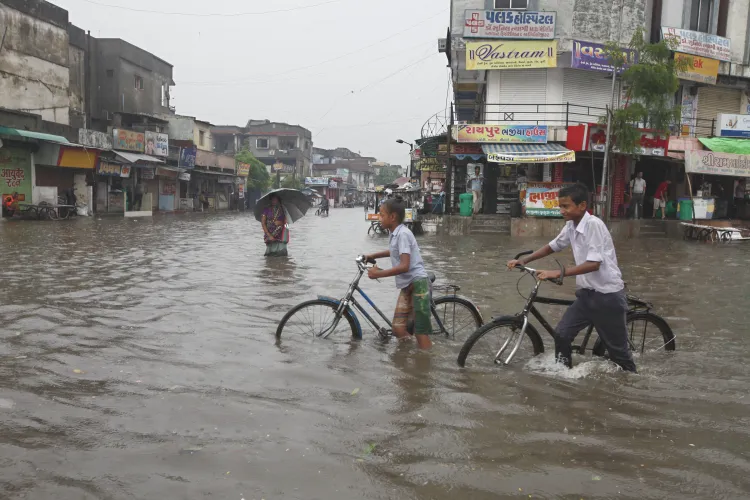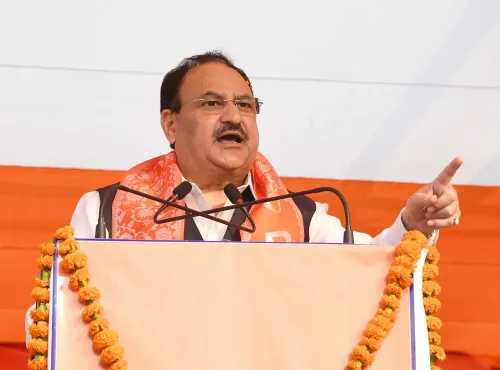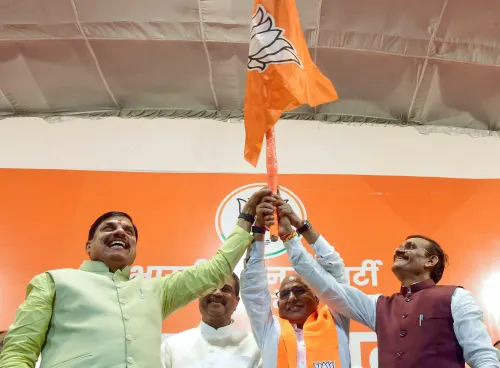Are Unseasonal Rains Impacting Valsad? IMD Issues Heavy Rain Warning for Gujarat

Synopsis
Key Takeaways
- Unseasonal rains have heavily impacted Valsad and surrounding areas.
- The IMD predicts more heavy rainfall in the coming days.
- Farmers are concerned about crop damage due to unexpected weather changes.
- Gujarat's rainfall is nearing seasonal averages, yet regional disparities exist.
- Local reservoirs are at varying capacities, indicating water management challenges.
Gandhinagar, Oct 23 (NationPress) A surprising shift in the weather has brought substantial rainfall and strong winds to various regions of Gujarat. The India Meteorological Department (IMD) has issued a warning of heavy rainfall affecting both Gujarat and southern India.
In the district of Valsad, located in South Gujarat, notable weather changes were observed on Thursday, where intense downpours and robust winds led to conditions resembling a ‘mini cyclone’. Areas within Valsad city and nearby regions, including Dharampur and Kaprada, experienced significant rainfall. Villages such as Phulwadi, Jharia, Bhensdhara, Barolia, Dhamni, and Bilpudi reported severe rain, with strong winds causing damage to sections of the District Seva Sadan building.
Low-lying neighborhoods within the city were flooded, leading to concerns among farmers regarding potential harm to winter crops due to the unexpected rain at the beginning of the new year.
The IMD forecasts that unseasonal rainfall may persist in parts of South Gujarat, as well as in Sabarkantha, Mahisagar, and Aravalli districts. Rainfall intensity is predicted to escalate starting from October 25, with heavy showers anticipated over South Gujarat, Saurashtra, and Kutch.
As of now, Gujarat has experienced rainfall totaling approximately 90 percent of its seasonal average up until August 31, following the onset of the southwest monsoon on June 15. Specifically, South Gujarat and North Gujarat recorded around 94 percent of their usual rainfall, while East-Central districts noted about 89 percent.
Earlier this season, as of August 1, South Gujarat had received around 997 mm (about 67 percent of its seasonal average) and North Gujarat received 470 mm (approximately 65 percent).
During June and July, the state documented around 450.5 mm of rainfall, with June contributing about 303 mm and July about 147 mm. While overall figures are relatively close to average, there is considerable regional variation, raising concerns about unseasonal rainfall and the risk of crop damage as post-monsoon disturbances begin to influence the state.
By August 2025, the Sardar Sarovar Dam on the Narmada River was reported to be over 75 percent full, holding 252,399 mcft of water. Across the state’s approximately 206 other reservoirs, storage averaged around 69.62 percent of capacity — with 31 reservoirs at full capacity, 72 between 70-100 percent, and 33 still below 25 percent. Earlier in the season, by July 1, major dams collectively held about 48.68 percent of their capacity (with Sardar Sarovar at approximately 48.23 percent).









